1. Background introduction
Near-α high-temperature titanium alloys are key structural materials for the manufacture of aero-engine rotation components. The compressor discs or blisks are held at peak stress for a period of time, resulting in a fatigue life that is less than the conventional low-cycle fatigue life, a phenomenon known as dwell fatigue. In service under stringent conditions, (0001) basal fracture caused by dwell loads is the most significant cause of engine core material failure, which poses a significant risk to component safety and has historically resulted in a number of fatalities. Therefore, the analysis of dwell fatigue failure and how to improve the dwell life has become a research hotspot in the field of aero-engine. The dominant view on dwell fatigue crack initiation mainly consists of the soft/hard grain crack nucleation model, where hard grains are considered to be difficult to deform, but the deformation of neighbouring softly oriented grains can promote the formation of basal slip in hard grains leading to basal cracking. It is well known that twinning is an effective means of coordinating hard oriented grains that are difficult to deform, but unfortunately it is usually difficult to activate the twinning of near-α titanium alloys at room temperature, and so far no domestic or foreign reports on the coordinated deformation of near-α titanium alloys by twinning have been made. However, for the first time, we found the presence of deformation twins in basal fracture grains in the initiation region of near-α titanium alloys with dwell failure cracks. The complexity of the dwell deformation and the basal tendency of crack nucleation make the mechanism of the microscopic effect of twinning on basal slip and crack initiation unclear. Therefore, revealing the intrinsic mechanism of the twin coordination effect is of great significance for the design of aerospace rotating components against dwell fatigue.
2. Achievement introduction
Recently, Professor Zeng Weidong's team at the School of Materials, Northwestern Polytechnical University (NPU), in collaboration with Wang Qingjiang's team at the Institute of Metals, Chinese Academy of Sciences (IMS, CAS), found for the first time that dwell load-induced twinning preferentially coordinates the deformation of (0001) basal grains as well as retards the basal crack propagation caused by basal slip in the near-alpha Ti60 alloy, which improves the fatigue resistance. Based on the soft/hard grain crack nucleation model for dwell fatigue, a new possible mechanism for the soft (P)/hard (B) grain PB interface to participate in twin nucleation is proposed. The high density of pyramidal < c+a > dislocations within the twins and their decomposition to form basal stacking faults (SFTs) with specific nanometre spacing make the coordination process accompanied by significant lattice distortions within the twins. The newly formed nanotwin boundaries and SFTs in these basal grains act as barriers to dislocation motion, increasing the strength and dwell life of the near-α Ti60 alloy and effectively reducing the dwell sensitivity of the alloy. The results extend the understanding of the synergistic effects of dislocation slip, twin nucleation and the formation of basal SFTs in near-α titanium alloy DF, and emphasise that the introduction of twins and SFTs plays an important role in alleviating DF crack initiation and enhancing fatigue resistance. The related work was published in the Top1 journal in the field of plasticity, International Journal of Plasticity, under the title of " Near-α titanium alloy dwell load-induced deformation twinning to coordinate the deformation mechanism associated with crack initiation". The first author of this work is Boning Wang, a PhD student at the School of Materials, Northwestern Polytechnical University, and the corresponding author is Professor Weidong Zeng.
Cite this article:
Boning Wang, Weidong Zeng*, Zibo Zhao*, Runchen Jia, Jianwei Xu, Qingjiang Wang, Near-α titanium alloy dwell load-induced deformation twinning to coordinate the deformation mechanism associated with crack initiation, International Journal of Plasticity. Volume 182, 2024, 104116. ISSN 0749-6419,
https://doi.org/10.1016/j.ijplas.2024.104116.
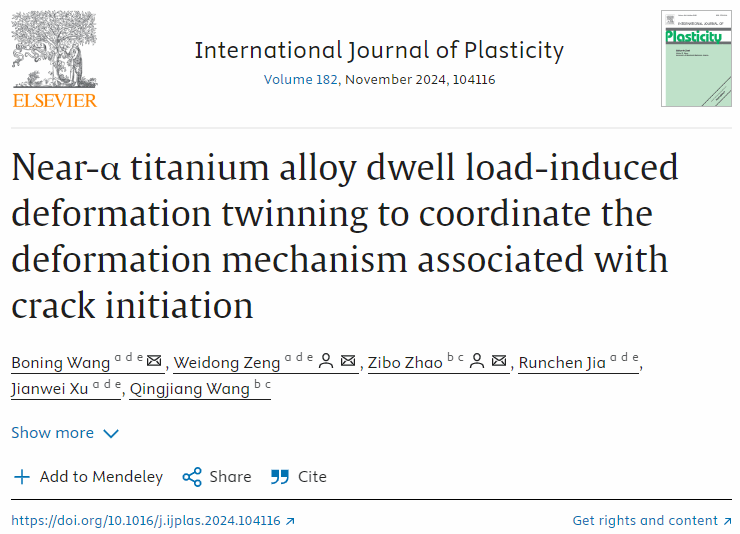
1. Text and image analysis
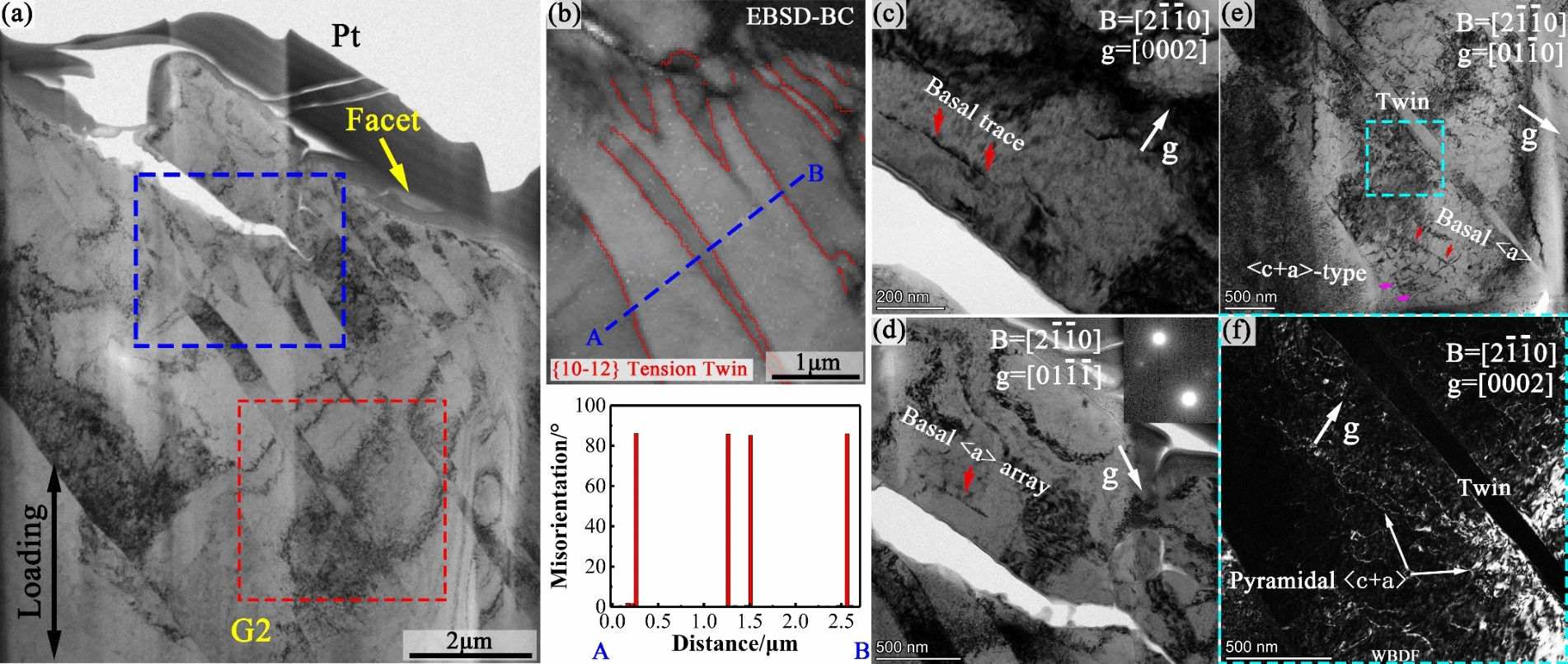
Fig. 1. FIB-TEM foils of G2 grains in the initiation region of the no-MTR DF sample: (a) TEM cracks and facet morphology, (b) EBSD BC maps and misorientation, (c) and (d) two-beam conditions in the microcracked region, and (e) and (f) two-beam conditions at the positions adjacent to the matrix and the twin.
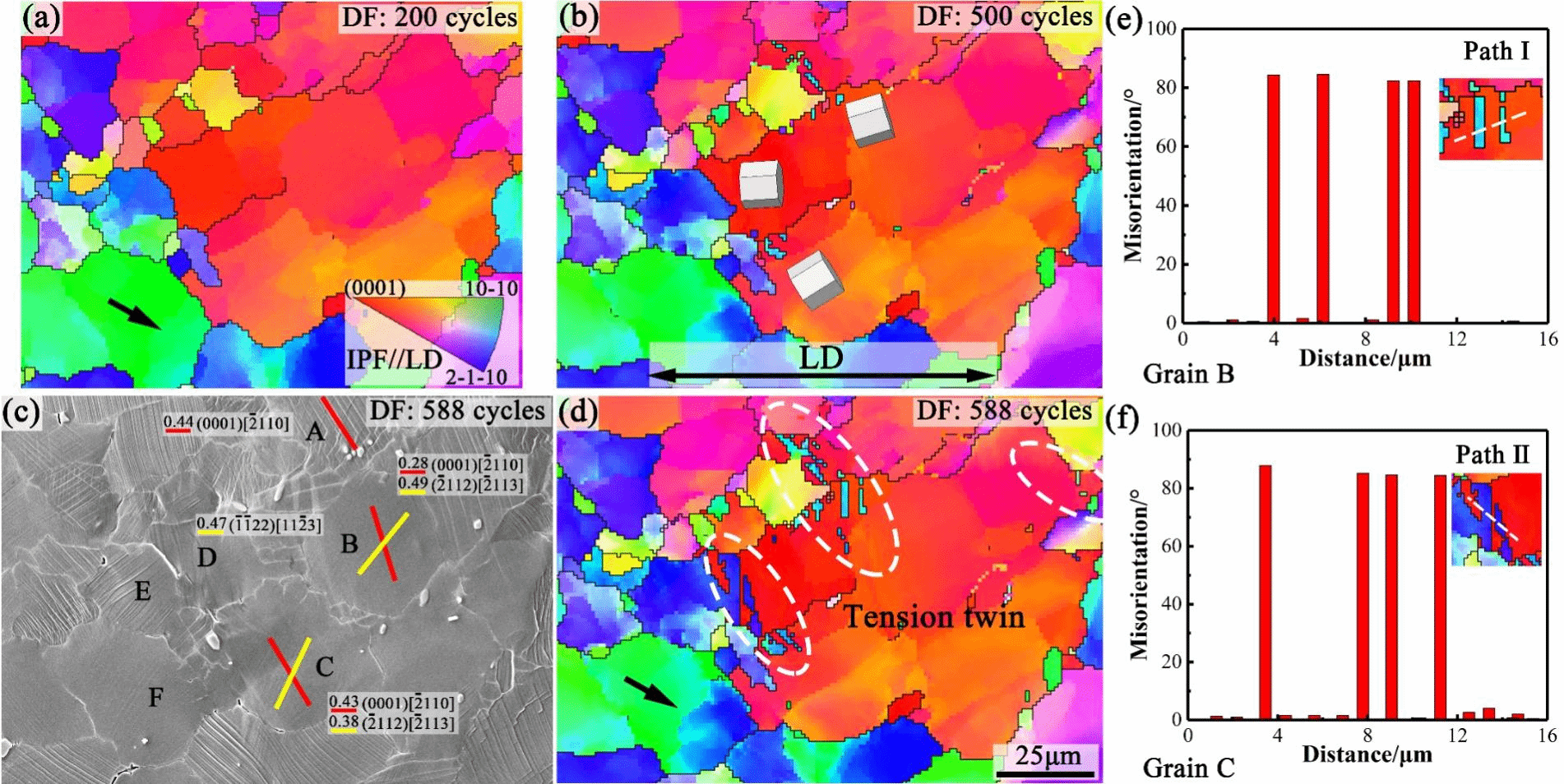
Fig. 2. SEM-EBSD IPF//LD (a-d) showing the nucleation growth of {10-12} twins during in situ dwell of MTR samples, (e) and (f) the distribution of misorientation along paths I and II in Fig. (d).
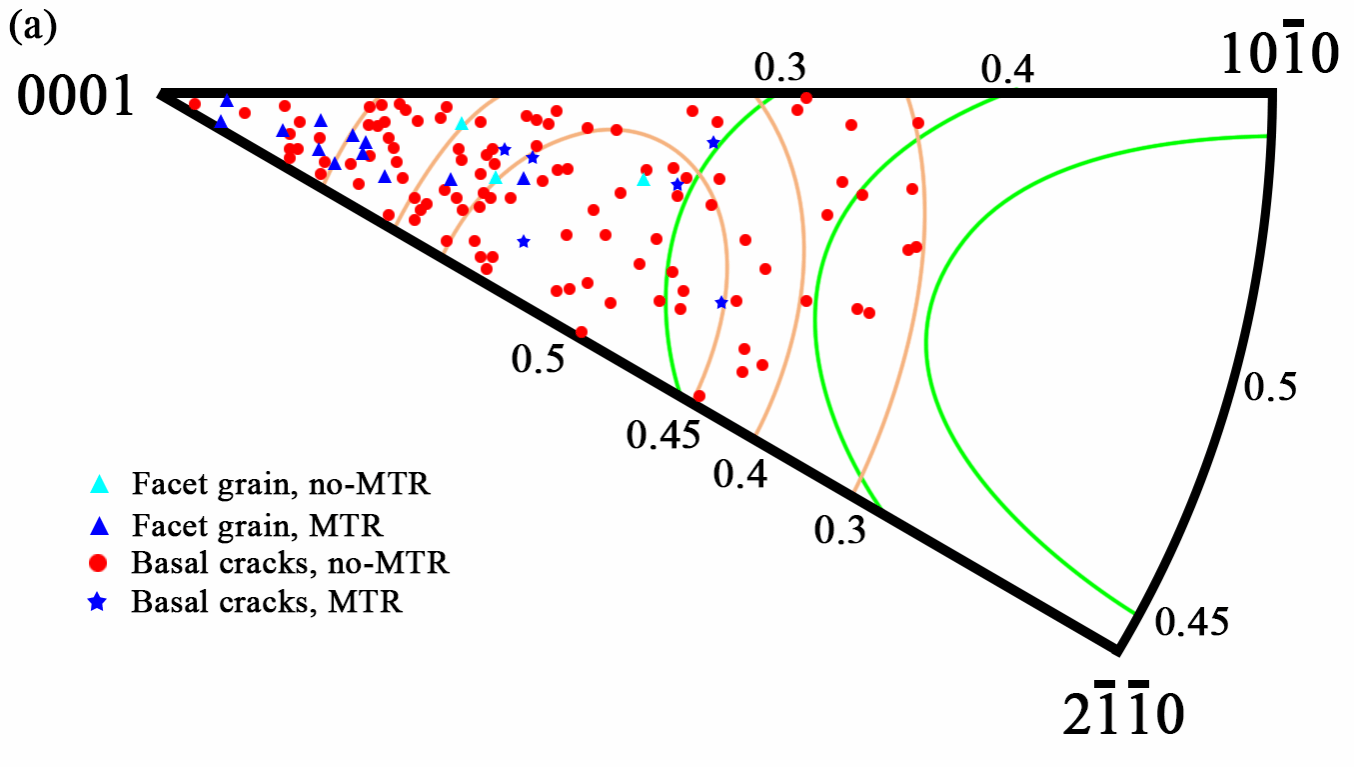
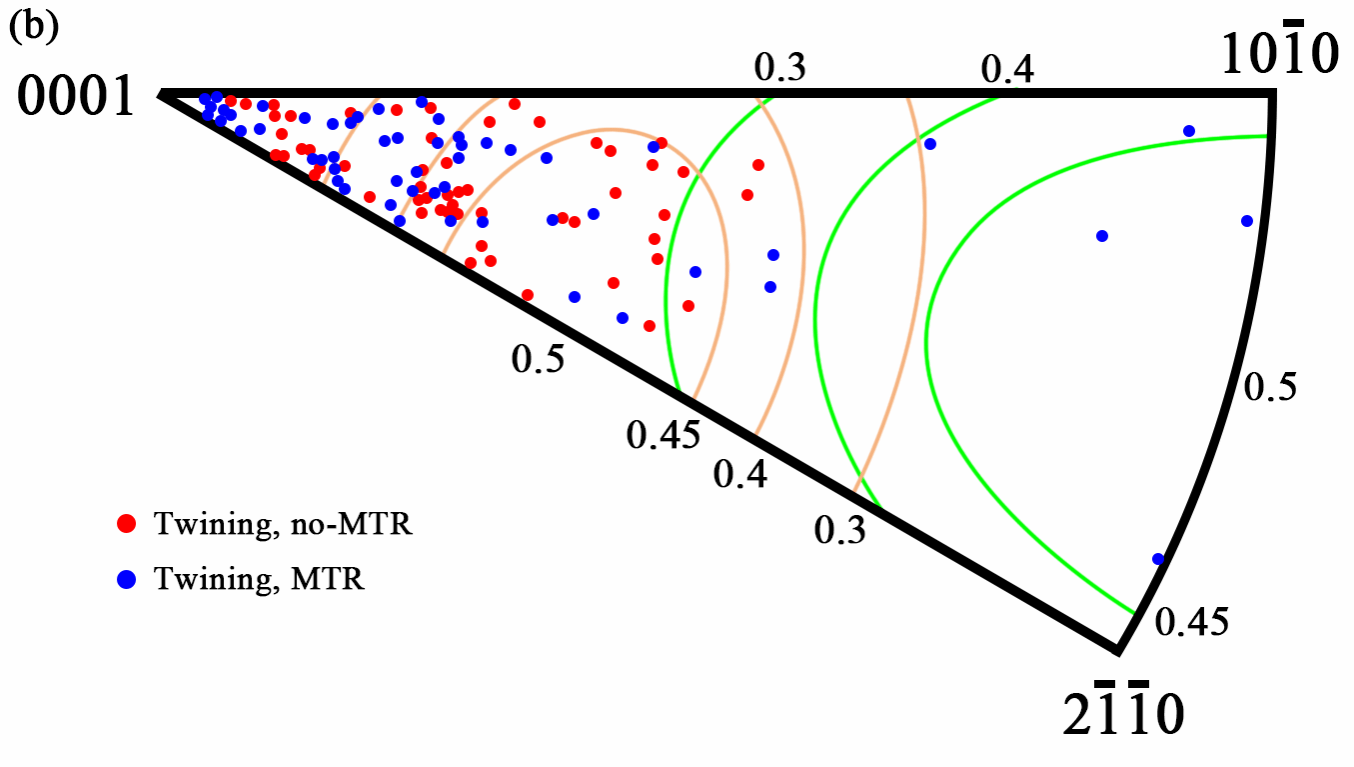
Fig. 3. Inverse pole figure of crystal orientation of the crack initiation grains and containing twins in DF samples with different micro-textures relative to the LD. The isocontours of the maximum SF correspond to, from left to right, the basal and prismatic slip systems, respectively.
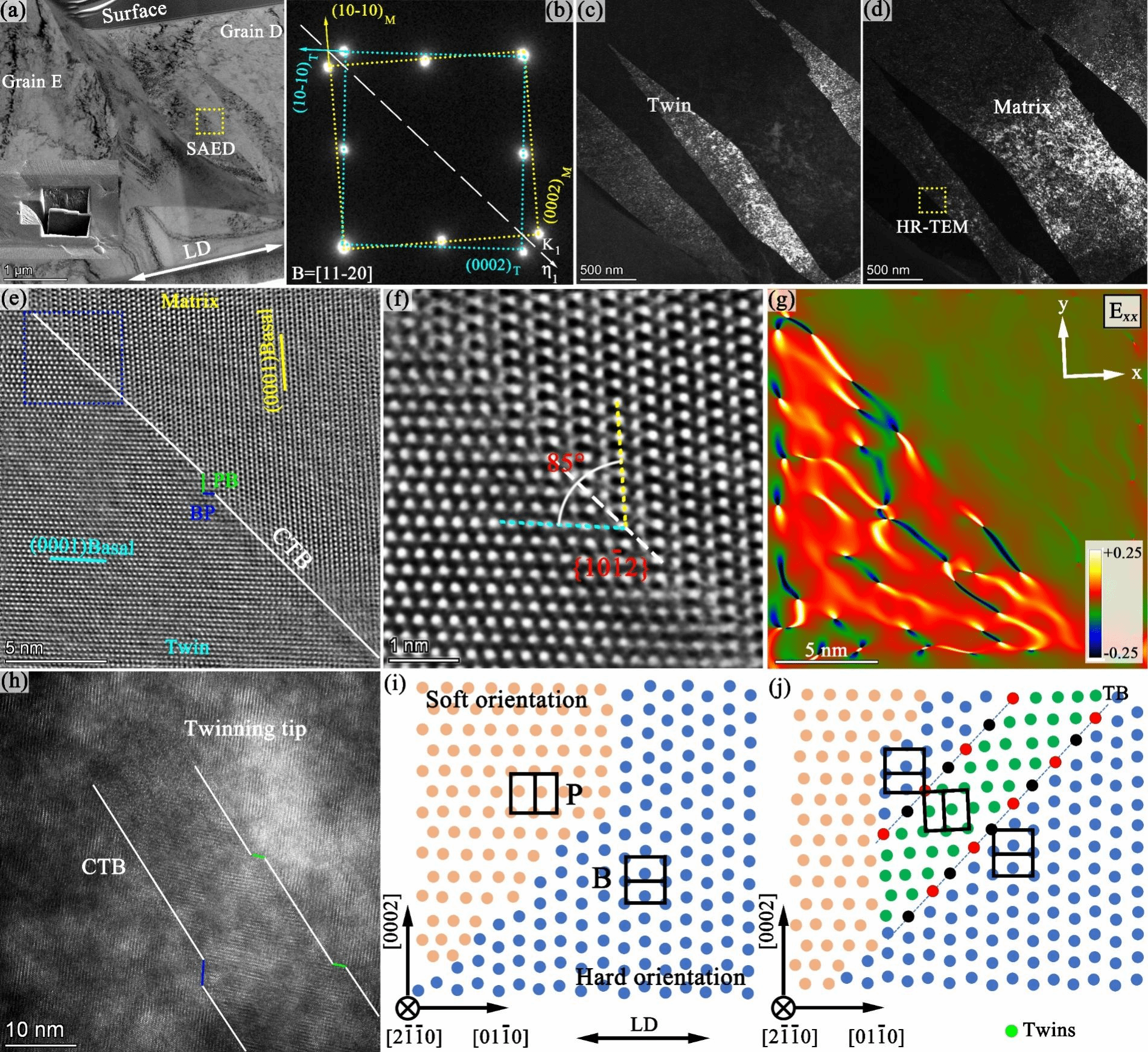
Fig. 4. (a) The morphology of the prepared FIB-TEM foils, (b) SAED pattern corresponding to the twin boundary (TB) in the region marked by the yellow dotted box in (a), with the zone axis [2 0], (c) and (d) Dark field images of the twin and matrix, respectively, (e) Atomic-scale [2
0], (c) and (d) Dark field images of the twin and matrix, respectively, (e) Atomic-scale [2 0] HAADF-STEM image of the marker in (d) showing a TB, (f) Localized enlarged interface structure of HAADF-STEM in the blue dotted box region in (e), (g) In-plane (Exx) strain field maps obtained by GPA of the Fig .e HAADF-STEM image, (h) HR-TEM of the twin tips in Fig. c, (i) Atomic schematic of the PB/BP interface corresponding to the soft/hard grain prismatic plane and the basal plane, (j) Schematic representation of atoms with twinned nucleation in hard grains.
0] HAADF-STEM image of the marker in (d) showing a TB, (f) Localized enlarged interface structure of HAADF-STEM in the blue dotted box region in (e), (g) In-plane (Exx) strain field maps obtained by GPA of the Fig .e HAADF-STEM image, (h) HR-TEM of the twin tips in Fig. c, (i) Atomic schematic of the PB/BP interface corresponding to the soft/hard grain prismatic plane and the basal plane, (j) Schematic representation of atoms with twinned nucleation in hard grains.
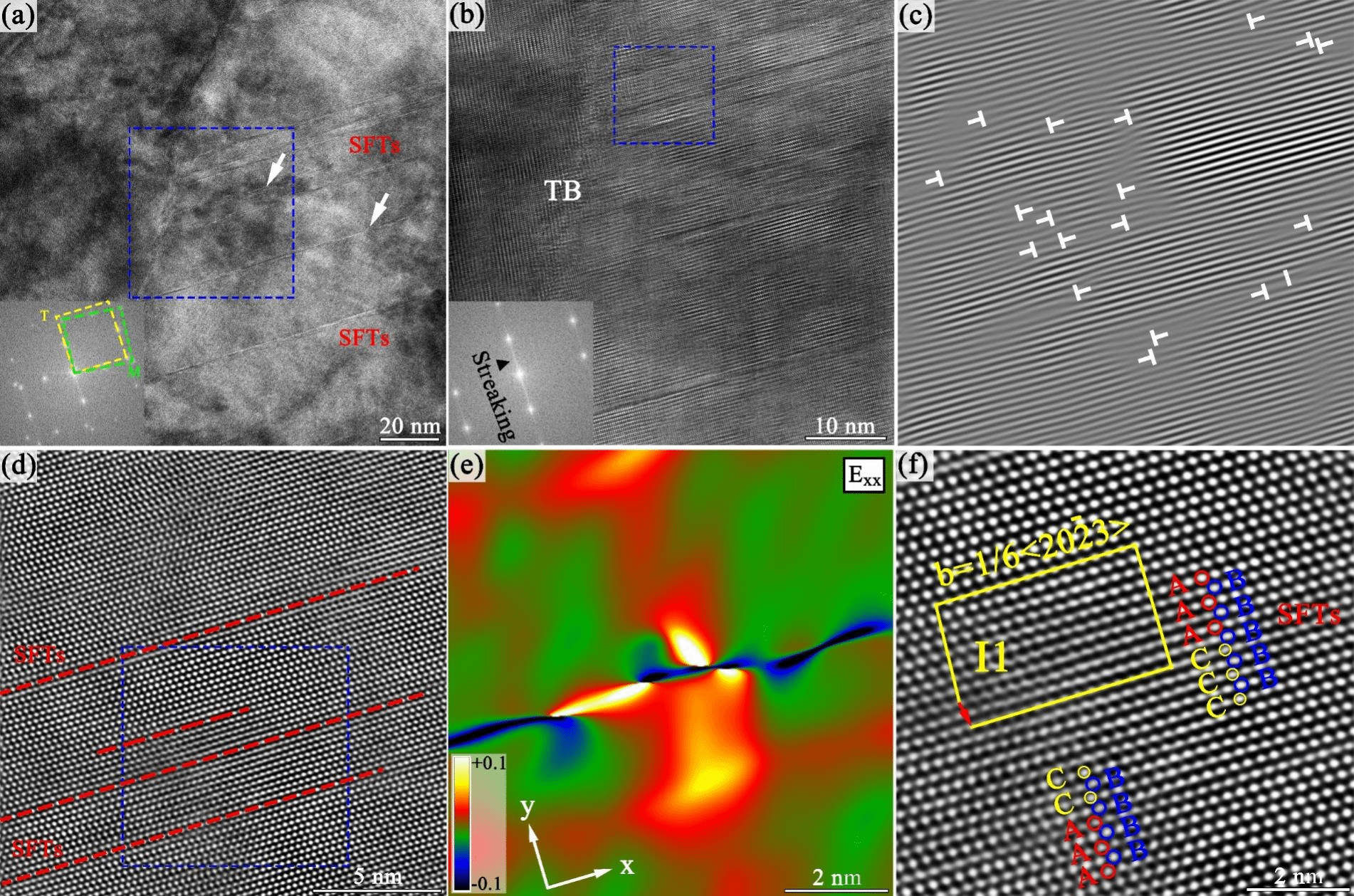
Fig. 5. Microstructure of twins and SFTs revealed by HR-TEM. (a-b) HR-TEM image and corresponding FFT showing SFTs in a {10-12} twin. (b) High magnification image of the blue dotted box in (a). (c) The blue dotted box in (b) corresponds to the (0002) basal plane IFFT image and dislocation characteristics. (d) Atomic-scale HAADF-STEM images of SFTs. (e) GPA analysis corresponding to the dotted box in (d). (f) HAADF-STEM image showing an I1 fault bounded by 1/6 < 2023 > Frank partial dislocations.
4. Conclusions and outlook
In this study, by focusing on the characteristics of the presence of deformation twins in the fracture source region of Ti60 titanium alloys with dwell fatigue (DF), we systematically investigated the relationship between twin nucleation and crack initiation and their deformation mechanisms, in particular, whether the presence of twins helps to co-ordinate (0001) basal surface cracking and improve DF life. The following conclusions were drawn: the DF crack initiation planes were all aligned with the basal plane and were associated with basal slip. Interdependence of DF crack initiation orientation and twin nucleation orientation determines the preferential coordination of twins and their participation in the basal crack initiation process. The local stress state at the soft/hard grain configuration leads to activation of pyramidal < c+a > dislocations and enlargement of the twins from the hard grain GBs rather than stimulation of twin nucleation by slip of neighbouring dislocations. At the same time, the PB interface of soft (P)/hard (B) grains is proposed as another possible mechanism for twinning nucleation. Deformation twins have higher lattice strain compared to the matrix, and their internal < c+a > dislocations and their dissociation to form high-density SFTs further coordinate the deformation and impede dislocation motion. The activation of deformation twins and the availability of other plastic deformation mechanisms within the TB can release local stress concentrations, delay premature cracking of the basal grains and stop the propagation of basal cracks during fatigue of Ti60 alloys, and this study highlights the importance of the twinned structure in fatigue failure prediction models for materials.
5. Brief introduction of communication author

Zeng Weidong, Professor and Doctoral Supervisor, School of Materials, Northwestern Polytechnical University, China. Has presided over and undertaken the National Key Research and Development Programme, the National "973 plan", the National Natural Science Foundation of China, the National Science and Technology Support Programme, the Ministry of Education Doctoral Fund, the Ministry of Education Outstanding Talent Plan and other scientific research projects. The group proposed a new process of near-beta forging of titanium alloy for the first time in China, obtaining a three-state microstructure combining equiaxed and basketweave structure, and won the second prize of the National Scientific and Technological Progress. In addition, it has won two first-class and one second-class prizes for scientific and technological progress in Shaanxi Province, and one second-class and one third-class prize for scientific and technological progress from the State Education Commission. He has been awarded the title of "Ministry of Education's New Century Outstanding Talents Programme", "Shaanxi Provincial Youth Science and Technology Award", and "Outstanding Young Teachers of Shaanxi Higher Education System Communist party member". He has published over 300 papers in well-known domestic and international journals, including *Acta Materialia*, *International Journal of Plasticity*, *Journal of Materials Science & Technology*, *Journal of Alloys and Compounds*, and *Materials Science and Engineering A*.